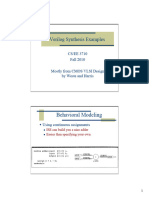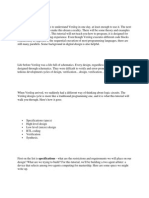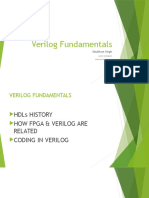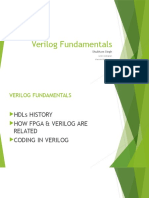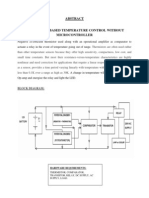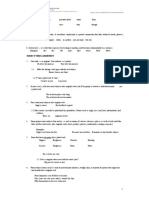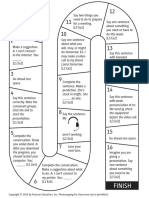A Brief Intro to Verilog
Brought to you by: Sat Garcia
Meet your 141(L) TA
Sat Garcia
sat@cs.ucsd.edu 2nd
Year Ph.D. Student Office Hours: (Tentative)
Place: EBU3b B225 (basement) Monday: 3-4pm Wednesday: 11am-Noon Please come to my office hours. I get lonely there by myself!
2
�What is Verilog?
Verilog is:
A
hardware design language (HDL) Tool for specifying hardware circuits Syntactically, a lot like C or Java An alternative to VHDL (and more widely used) What you'll be using in 141L HELLA COOL!*
3 * If you are totally into hardware design languages
Verilog in the Design Process
Behavioral Algorithm Manual Register Transfer Level Logic Synthesis Simulate Gate Level Auto Place + Route Test Results Simulate Test Results Test Results
Adapted from Arvind & Asanovics MIT 6.375 lecture
�Ways To Use Verilog
Structural Level
Lower
level
Has all the details in it (which gates to use, etc)
Is
always synthesizable Level
Functional Level
Higher
Easier to write
Gate level, RTL level, high-level behavioral Not always synthesizable
Well be sticking with functional mostly
5
Data Types in Verilog
Basic type: bit vector
Values:
0, 1, X (don't care), Z (high impedence)
Bit vectors expressed in multiple ways:
binary:
4'b11_10 ( _ is just for readability) hex: 16'h034f decimal: 32'd270 other formats but these are the most useful
6
�Data types (continued)
Connect things together with: wire
Single
wire: of wires
wire my_wire;
Array
wire[7:0] my_wire; Why not wire[0:7]?
For procedural assignments, we'll use reg
Again,
can either have a single reg or an array
reg[3:0] accum; // 4 bit reg
reg
is not necessarily a hardware register
7
A simple example (comb. circuit)
Let's design a 1 bit full adder
a b cin cout
FA
s
module FA( input a, b, cin, output s, cout); assign s = a ^ b ^ c; assign cout = (a & b) | (a & cin) | (b & cin); endmodule *** Note: red means new concept, blue and green are just pretty colors :-p
Ok, but what if we want more than 1 bit FA?
Adapted from Arvind & Asanovics MIT 6.375 lecture
8
�A 4-bit Full Adder
We can use 1 bit FA to build a 4 bit full adder
FA
FA
FA
FA
module 4bitFA( input [3:0] A, B, input cin, output [3:0] S, output cout); wire c0, c1, c2; FA fa0(A[0],B[0],cin,S[0],c0); // implicit binding FA fa1(.a(A[1]), .b(B[1]), .cin(c0), .s(S[1]), .cout(c1)); // explicit binding FA fa2(A[2],B[2],c1,S[2],c2); FA fa3(A[3],B[3],c2,S[3],cout); endmodule
Adapted from Arvind & Asanovics MIT 6.375 lecture
Testing the adder
`timescale 1ns/1ns // Add this to the top of your le to set time scale module testbench(); reg [3:0] A, B; reg C0; wire [3:0] S; wire C4; 4bitFA uut (.B(B), .A(A), .cin(C0), .S(S), .cout(C4)); // instantiate adder initial // initial blocks run only at the beginning of simulation (only use in testbenches) begin $monitor($time,"A=%b,B=%b, c_in=%b, c_out=%b, sum = %b\n",A,B,C0,C4,S); end initial begin A = 4'd0; B = 4'd0; C0 = 1'b0; #50 A = 4'd3; B = 4'd4; // wait 50 ns before next assignment #50 A = 4'b0001; B = 4'b0010; // dont use #n outside of testbenches end endmodule
10
�Verilog RTL Operators
Arithmetic Logical Relational Equality Bitwise
+ - * / % ** ! && || > < >= <= == != === !=== ~ & | ^ ^~
Reduction Shift Concatenation Conditional
& ~& | ~| ^ ^~ >> << >>> <<< { } ?:
Avoid using %, **, and / because you'll run into problems when trying to synthesis
Adapted from Arvind & Asanovics MIT 6.375 lecture
11
A simple D flip flop (seq. circuit)
For sequential circuits, use always blocks Always blocks (and assign) are executed in parallel!
module DFF( input clk, d, output q, q_bar); reg q, q_bar; always @ (posedge clk) // triggered on the rising edge of the clock begin q <= d; // non-blocking assignment (LHS not updated until later) q_bar <= ~d; /* q_bar <= ~q will not function correctly! */ end endmodule
Adapted from Arvind & Asanovics MIT 6.375 lecture
12
�Always blocks in comb. circuits
Can use continual assignment AND always blocks for combinational circuits Our 1-bit adder using always block
module FA( input a, b, cin, output s, cout); reg s, cout; // when using always block, LHS must be reg type always @ ( a or b or cin ) // for comb circuits, sensitive to ALL inputs begin s = a ^ b ^ cin; // use blocking assignment here (LHS immediately) cout = (a & b) | (a & cin) | (b & cin); end endmodule
13
Quick Note on blocking vs. nonblocking
Order of blocking statements matter
These
c = a + b; d = c + e;
are not the same
d = c + e; c = a + b;
Order of non-blocking statements doesnt
These
are the same
c <= a + b; d <= c + e; d <= c + e; c <= a + b;
Use non-blocking with sequential, blocking with combintational
14
�Tips for maintaining synthesizability
Only leaf modules should have functionality
All other modules are strictly structural, i.e., they only wire together sub-modules
Use only positive-edge triggered flip-flops for state Do not assign to the same variable from more than one always block Separate combinational logic from sequential logic Avoid loops like the plague
Use for and while loops only for test benches
Adapted from Arvind & Asanovics MIT 6.375 lecture
15
Another Example (4 input MUX)
We can use case statements within an always block
module mux4( input a, b, c, d, input [1:0] sel, output out ); reg out; always @( * ) begin case ( sel ) 2d0 : out = a; 2d1 : out = b; 2d2 : out = c; 2d3 : out = d; default : out = 1bx; endcase end endmodule
Adapted from Arvind & Asanovics MIT 6.375 lecture
16
�Finite State Machines (FSMs)
Useful for designing many different types of circuits 3 basic components:
Combinational
logic (next state) Sequential logic (store state) Output logic
Different encodings for state:
Binary
(min FFs), Gray, One hot (good for FPGA), One cold, etc
17
A simple FSM in Verilog
module simple_fsm( input clk, start, output restart); reg [1:0] state, next_state; parameter S0 = 2b00, S1 = 2b01, S2 = 2b10; // binary encode always @ (*) begin : next_state_logic case ( state ) S0: begin if ( start ) next_state = S1; else next_state = S0; end // continued from left S1: begin next_state = S2; end always @ (posedge clk) S2: begin begin: state_assignment if (restart) next_state = S0; state <= next_state; else next_state = S2; end end endmodule default: next_state = S0; endcase end // continued to the right
18
�Tips on FSMs
Dont forget to handle the default case Use two different always blocks for next state and state assignment
Can
do it in one big block but not as clear
Outputs can be a mix of combin. and seq.
Moore
Machine: Output only depends on state Mealy Machine: Output depends on state and inputs
19
Next step: design your own HW
Now that you have the basics
Check
out MITs 6.375 course webpage
Thanks to Asanovic & Arvind for slides Lectures 2 and 3 on Verilog http://csg.csail.mit.edu/6.375/handouts.html
Try
making some simple circuits Beware when Googling for verilog tutorial
A lot of code out there isnt synthesizable
20
10





